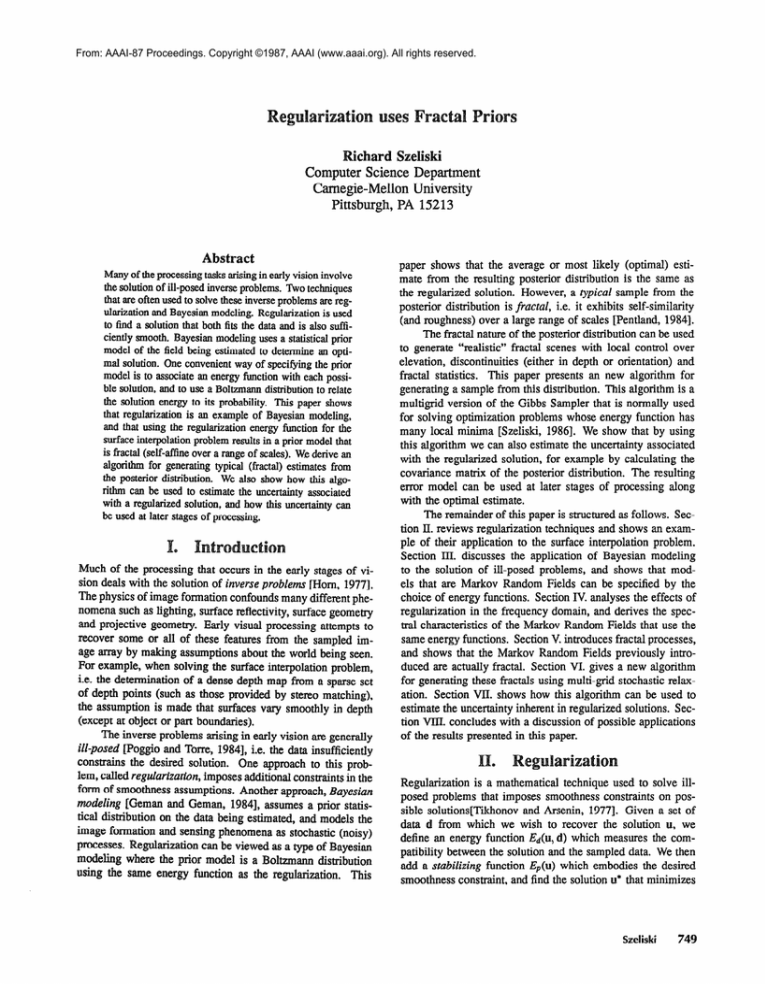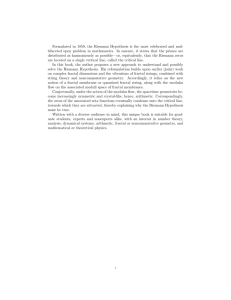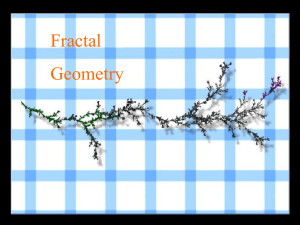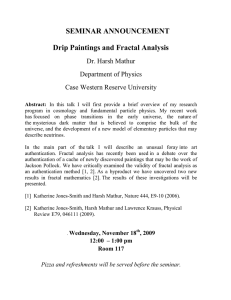
From: AAAI-87 Proceedings. Copyright ©1987, AAAI (www.aaai.org). All rights reserved.
shard Szeliski
Computer Science Department
Carnegie-Mellon University
Pittsburgh, PA 15213
Abstract
Many of the processing tasks arising in early vision involve
the sclution of ill-posed inverse problems. Two techniques
that are often used to solve these inverse problems are reguhuization and Bayesian modeling. Reguhuizatien is used
to find a solution that both fits the data and is also sufficiently smooth. Bayesian modeling uses a statistical prior
model of the field being estimated to determine an optimal solution. One convenient way of specifying the prior
model is to associate an energy function with each possible solution, and to use a Boltzmann distribution to relate
the solution energy to its probability. This paper shows
that regularization is an example of Bayesian modeling,
and that using the regularization energy function for the
surface interpolation problem results in a prior model that
is fractal (self-aftine over a range of scales). We derive an
algorithm for generating typical (fractal) estimates from
the posterior distribution. We also show how this algorithm can be used to estimate the uncertainty associated
with a regularized solution, and how this uncertainty can
be used at later stages of processing.
Much of the processing that occurs in the early stages of vision deals with the solution of inverse problems [Hmm, 19771.
The physics of image formation confounds many different phenomena such as lighting, surface reflectivity, surface geometry
and projective geometry. Early visual processing attempts to
recover some or all of these features from the sampled image array by making assumptions about the world being seen.
For example, when solving the surface interpolation problem,
i.e. the determination of a dense depth map from a sparse set
of depth points (such as those provided by stereo matching),
the assumption is made that surfaces vary smoothly in depth
(except at object or part boundaries).
The inverse problems arising in early vision ate generally
ill-posed [Poggio and Terre, 19841, i.e. the data insufficiently
constrains the desired solution.
One approach to this problem, cakl regularization, imposes additional constraints in the
form of smoothness assumptions. Another approach, &yes&an
modeling [Geman and Geman, 19841, assumes a prior statistical distribution on the data being estimated, and models the
image
and sensing phenom
as stochastic (noisy)
proces
arization can be vie
as a type of Bayesian
modeling where the prior model is a Boltzmatm distribution
using the same energy function as the regularization.
This
paper shows that the average or most likely (optimal) estimate from the resulting posterior distribution is the same as
the regularized solution. However, a typical sample from the
posterior distribution is fractal, i.e. it exhibits self-similarity
(and roughness) over a large range of scales [Pentland, 19841.
The fractal nature of the posterior distribution can be used
to generate “realistic” fractal scenes with local control over
elevation, discontinuities
(either in depth or orientation) and
fractal statistics.
This paper presents an new algorithm for
generating a sample from this distribution. This algorithm is a
multigrid version of the Gibbs Sampler that is normally used
for solving optimization problems whose energy function has
many local minima [Szeliski, 19861. We show that by using
this algorithm we can also estimate the uncertainty associated
with the regularized solution, for example by calculating the
covariance matrix of the posterior distribution. The resulting
error model can be used at later stages of processing along
with the optimal estimate.
The remainder of this paper is structured as follows. Section II. reviews reguhuization techniques and shows an example of their application to the surface interpolation problem.
Section III. discusses the application of Bayesian modeling
to the solution of ill-posed problems, and shows that models that are Markov Random Fields can be specified by the
choice of energy functions. Section IV. analyses the effects of
regularization in the frequency domain, and derives the spectral characteristics of the Markov Random Fields that use the
same energy functions. Section V. introduces fractal processes,
and shows that the Markov Random Fields previously introduced are actually fractal. Section VI. gives a new algorithm
for generating these fractals using multi-grid stochastic relaxation. Section VII. shows how this algorithm can be used to
estimate the uncertainty inherent in regularized solutions. Section VIII. concludes with a discussion of possible applications
of the results presented in this paper.
0
ria
Regularization is a mathematical technique used to solve illposed problems that imposes smoothness constraints on possible solutions[Tilchonov
and Arsenin, 19771. Given a set of
data d from which we wish to recover the solution u, we
define an energy function I?& d) which measures the compatibility between the solution and the sampled data. We then
add a stabilizing function E,(U) which embodies the desired
smoothness constraint, and find the solution U* that minimizes
Szeliski
749
Figure 1: Sample data points
Figure 2: Regularized
(thin plate) solution
the total energy
E(u) = Ed@, d) + XE,(u)
(1)
The regularization parameter X controls the amount of smoothing performed. In general, the data term d and solution u can
be vectors, fields (two-dimensional
arrays of data such as images or depth maps), or analytic functions (in which case the
energy is a functional).
For the surface interpolation problem, the data is usually
a sparse set of points { di}, and the desired solution is a twodimensional function U(X,y). The data compatibility term can
be written as a weighted sum of squares
EI(u, d) = ; C
Two examples of possible smoothness
brane model [Terzopoulos, 19841
Ep(u) = ;
which is a small deflection
and the thin plate model
Ep(u) = ;
(2)
WiCub, Yd - &I2
functionals
are the mem-
hdr
JJ <u:+4)
JJ
approximation
(2&+2z&+4
(3)
of the surface area,
dxdy
which is a small deflection approximation of the surface curvature (note that here the subscripts indicate partial derivatives).
These two models can be combined into a single functional by
using additional “rigidity” and “tension” functions, in order
to introduce depth or orientation discontinuities perzopoulos,
19861.
As an example of a controlled-continuity
regularizer, consider the nine data points shown in Figure 1. The regularized
solution using a thin plate model is shown in Figure 2. Note
that a depth discontinuity has been introduced along the left
edge, an orientation discontinuity along the right, and that the
regularized solution is very smooth away from these discontinuities.
The above stabilizer E’(u) is an example of the more
general controlled-continuity
constraint
750
Vision
where x is the (multi-dimensional)
domain of the function u.
This general formulation will be used in Section IV. to derive
the spectral (frequency domain) characteristics of the stabilizer.
III.
ayesia
The Bayesian modeling approach uses an Q priori distribution p(m) on the data being estimated, and a stochastic process
p(d(u) relating the sampled data (input image) to the original
data. According to Bayes’ Rule, we have
p(uld) =
P(dlulP(u)
p(d)
(6)
In its usual application [Geman and Geman, 19841, Bayesian
modeling is used to find the Maximum A Posteriori (MAP)
estimate, i.e. the value of u which maximizes the conditional
probability p(uld). In the more general case, the optimal estimator u* is the value that minimizes the expected value of
a loss function L(u, u*) with respect to this conditional probability.
Recently, Bayesian models that use Markov Random
Fields have been used to solve ill-posed problems such as image restoration [Geman and Geman, 19841 and stereo matching
[Szeliski, 19861. A Markov Random Field (MRF) is a distribution where the probability of any one variable Ui is dependent
on only a few neighbors,
POJilU) =P<Uil{Uj}),
j E Ni
In this case, the joint probability distribution
ten as a Boltzmann (or Gibbs) distribution
P(U) 0~ exp [-E,(NI~]
(7)
p(u) can be writ-
(8)
where T is called the “temperature”.
The “energy function”
Ep(u) can be written as a sum of local clique energies
where each clique energy EC(u) depends only on a few neighbors. Typically, the clique energy characterizes the local violation of the prior model or smoothness constraint.
The random vector IUis sampled by a sensor which produces a data vector d. We will model the measurement process
as having additive (multivariate)
p(dlNQC
exp
Gaussian noise
-2 ’ (w - d)rA(u - d)
1
= exp [-Ed@,
=
PWp(dl
p(d)
(10)
d)]
N
= &&O/T
E,(u)
the Equations
= ;
14 and 15 to Equation
J IWI121WO12~f
5,
WI
0~ exp bW)l
where
E(u)
Applying
where
From Bayes rule, we have
P(+o
transform).
we obtain
+ Ed@,
(12)
f&
so that the posterior distribution is itself a Markov Random
Field. Thus MAP estimation is equivalent to finding the minimum energy state. This shows that regularization is an example of the more general MRF approach to optimal estimation.
The smoothing term (stabilizer) I?&(W)corresponds to the a
priori distribution, and the data compatibility
term Ed(u, d)
corresponds to the measurement process.
While Bayesian modeling has previously been used in
computer vision to find an optimal estimate, it has not been
used to generate an error model. We propose to estimate additional (second order) statistics using this model, and to use
these additional statistics at later stages of processing. For example, we can use these statistics when matching for object
recognition or pose detection, or to optimally integrate new
knowledge or measurements (by using Kalman filtering [Smith
and Cheeseman, 19851). We present a method for calculating
these statistics in Section VII..
For example, the membrane interpolator has 16;(f)12 oc 127rq2
and the thin plate model has lC(f)12 cx 127rf14.
Since the Fourier transform is a linear operation, if u(x)
is Boltzmann distributed with energy EJu), then U(f) is also
Boltzmann distributed with energy E,(U). Tbs we have
NWexp
[
-f
J
from which we see that the probability
quency f is
p(W)
0; exp
1
IW.J121W~12~f
distribution
WI
at any fre-
[-;lG(h121WO12]
(19)
Thus,
U(f) is a random Gaussian variable with variance
lW91-2, and the signal U(X) is correlated Gaussian noise with
a spectral distribution
Utf) = lWJl-2
(20)
We can also use the same Fourier analysis techniques to
determine the frequency response of regularization viewed as
linear filtering. The result of this analysis (see [Szeliski, 19871
for details) is that the effective smoothing filter has a frequency
response
1
By taking a Fourier transform of the function u(x) and expressing the energy equations in the frequency domain, we can
analyse the filtering behaviour of regularization and the spectral characteristics of the prior model. To simplify the analysis,
we will set the weighting function w,(x) used in Equation 5
to a constant. While this analysis does not strictly apply to
the general case, it provides an approximation to the local bebaviour of the regularized system away from boundaries and
discontinuities.
The Fourier transform [Bracewell, 19781 of a multidimensional signal h(x) is defined by
3(h)
3
and the transform
J
h(x) exp(2ni f. x) hr = H(f)
of its partial derivative
By using Parseval’s
theorem
we can derive the smoothness functional I&
Fourier transform U(f) = 3{ M}. The notation
the energy associated with a signal V, which
the original definition of E’(u) (in this case by
where o is the standard deviation of the sensor noise (with
uniform dense sensing). For the case of the membrane model
and the thin plate model, the shape of the frequency response
is qualitatively similar to that of Gaussian filtering. The overall posterior distribution (when the data confidence and prior
model are spatially uniform) is the superposition of the regularized (smooth) solution and some correlated Gaussian noise.
Fourier analysis can also be used to examine the convergence
properties of the iterative algorithms discussed in Section VI.
[Szeliski, 19871.
(13)
is given by
/ lhc@12dx= J lHm12df
(21)
H(f)= 1ca2;G(F)12
(15)
in terms of the
E&V) denotes
is derived from
using a Fourier
Fractals are objects (geometic
designs, coastlines, mountain
surfaces) that exhibit self-similarity
over a range of scales
[Mandelbrot, 19821. Fractals have been used to generate ‘“realistic” images of terrain or surfaces that exhibit roughness, and
to anal&
certain types of structured noise. Brownian f’ractals are-random processes or random fields that exhibit similar
statistics over a range of scales. One common way to characterize such a fractal is to say that it follows a power law in its
spectral density
Wf)
(22)
cx l/P
This spectral density characterizes a fractal Brownian function
v&) with 2H = ,d - E, whose f!ractal dimension is D = E+ I-
Szeliski
751
to pass through the points in Figure 1, and has a depth discontinuity along the left edge and an orientation discontinuity
along the right. The introduction of data points affects the
local noise characteristics. of the fractal without affecting the
prior statistics. It thus generates a representative random sample that is true both to the fractal statistics being used and to
the sampled (or desired) data points. This approach can also
be used for doing interpolation of digital terrain models. Interpolators that have a smoothing behaviour between that of a
membrane and a thin plate are better able to model the correct
smoothness (fractal dimension) of natural terrain.
e de
Figure 3: Fractal (random)
solution
H (where E is the dimension of the Euclidean space) [Voss,
19851.
The spectral density of the regularization based prior models examined in the previous section is lG(f,~j-~. For a membrane interpolator, we have
S tt&?Pnbrane(O
Qc1274-2
while for a thin plate interpolator,
Sthin--plate(O
(23)
we have
QC1274-’
(24
Thus, the prior models for a membrane and a thin plate are
indeed fractal, since the spectral density is a power of the
frequency.
The significance of this connection between regularization methods, I3ayesia.n models and fractal models is two-fold.
First, it shows that the smoothness assumptions embedded in
regularization methods are equivalent to assuming that the underlying processes is fractal. when regularization techniques
are used, it is usual to find the minimum energy solution (Figure 2), which also corresponds to the mean value solution for
those cases where the energy functions are quadratic. Thus,
the fractal nature of the process is not evident. A far more
representative solution can be generated if a random (fractal) sample is taken from this distribution.
Figure 3 shows
such a random sample, generated by the algorithm that will
be explained in section VI.. The amount of noise (and hence
“bumpiness”) that is desirable or appropriate can be derived
from the data [Szeliski, 19871.
Second, the connection between Bayesian models and
fractal models gives us a powerful new technique (described
in Section VI.) for generating fiactal surfaces for computer
graphics applications. Previous techniques for generating fractals use either recursive subdivision algorithms [Fournier et
al., 19821 or the addition of correlated (pink) noise to some
initial data [Pentland, 19841. While the latter algorithm is
equivalent to Bayesian modeling with uniform data and prior
models, the Bayesian modeling approach can be extended to
non-uniform data and the full controlled-continuity
constraint.
Thus, it is possible to constrain the desired fractal by placing control points at selected locations (using the discrete data
formulation), or to introduce discontinuities
such as cliffs or
ridges. For example, the f’ractal in Figure 3 has been required
tie
To simulate the Markov Random Field (or equivalently, to find
the minimum energy solution) on a digital or analog computer,
it is necessary to discretize the domain of the solution u(x) by
using a finite number of nodal variables. The usual and most
flexible approach is to use finite element analysis [Terzopoulos,
19841. We will restrict our attention to rectangular domains
on which a rectangular mesh has been applied. As well, the
input data points will be constrained to lie on this mesh.
As an example, let us examine the finite element approximation for the surface interpolation problem.
Using a
triangular conforming element for the membrane, and a nonconforming rectangular element for the thin plate (as in [Terzopoulos, 1984]), we can derive the energy equations
1
J%P&%dJrm(~)
= 2
for the membrane
&if4-plufc(~~
[(u~+~,~- u,,?
+ (h,y+l - uxJYi
(25)
3y -
+
(JhY)
and
=
2'w-2
~[(u,+*
2&z,, + &-l,y12
(X,Y)
2(U,+l,y+l
o&+1
-
-
Ux,y+l -
2k,y
Ux+l,y + ux,yj2 +
+ &c,y-l~21
(26)
for the thin plate, where 1AX] is the size of the mesh (isotropic
in x and y). These equations hold at the interior of the surface,
i.e. away from the border points and discontinuities.
Near
border points or discontinuities
some of the energy terms are
dropped or replaced by lower continuity terms (see [Szeliski,
19871 for details). The equation for the data compatibility term
is simply
Ed@,
d) =
;
x
%,y(Ux,y
-
4,y)2
(27)
(X,Y)
with
%,y = 0 at points where there is no input data.
If we concatenate all the nodal variables {u~,~} into one
vector uI, we can write the prior energy model as one quadratic
form
1
W-9
Ep(@ = z~TApw
This quadratic form is valid for any controlled continuity stabilizer, though the coefficients differ. Similarly, for the data
compatibility m
1 we can write
- Q)
(29)
where Ad is usually diagonal (for uncorrelated sensor noise).
The resulting overall energy function E(u) is quadratic in u
lT
E(m)= p.~ Au-u%+c
(30)
where
A=Ap+Ad
and has a minimum
and
lb=Add
(31)
at u*
u* =A-$
(32)
Once the parameters of the energy function have been determined, we can calculate the minimum energy solution u* by
using relaxation. For faster convergence on a serial machine,
we use Gauss-Seidel relaxation where nodes are updated one
at a time. At each step the selected node is set to the value that
(locally) minimizes the energy function. The energy function
for node Ui (with all other nodes fixed) is
1c
(33)
jENi
and so the new node variable value is
UT= bi - EjeNi a@j
‘
(34)
Qii
The result of executing this iterative algorithm on the nine
data points in Figure 1 is shown in Figure 2. Note that it is
possible to use a parallel version of Gauss-Seidel relaxation so
long as nodes that are dependent (have a non-zero ag entry)
are not updated simultaneously.
This parallel version can be
implemented on a mesh of processors for greater computational
speed
The stochastic version of Gauss-Seidel
relaxation is
known as the “Gibbs Sampler” [Geman and Geman, 19841
or Boltzmann Machine [Hinton et al., 19841. Nodes are updated sequentially (or asynchmnously), with the new nodal
value selected from the local Boltzmann distribution
(35)
Since the local energy is quadratic
E(Ui) = aii(Ui-
UT)2 +
k
(36)
this distribution is a Gaussian with a mean equal to the deterministic update value UT and a variance equal to T/aii. Thus,
the Gibbs Sampler is equivalent to the usual relaxation algorithm with the addition of some locally controlled Gaussian
noise at each step. The resulting surface exhibits the rough
(wrinkled) look of fractals (Figure 3). The amount of roughness can be controlled by the ‘“temperature” parameter T. The
“best” value for T can be determined by using parameter estimation techniques [Szeliski, 19871.
While the above iterative algorithms will eventually converge to the correct estimate, their performance in practice is
unacceptably slow. TQ overcome this, multigrid techniques
[Terzopoulos, 19841 can be used. The problem is first solved
on a coarser mesh, then this solution is used as a starting point
for the next finer level (thus this is a coarse-to-dine algorithm).
In previous work [Terzopoulos, 19841 a more complex interlevel coordination strategy was used, but in this instance it has
not been found to be necessary. The application of multigrid
techniques to stochastic algorithms requires some care, since
the energy equations must be preserved when mapping from a
fine to a coarse level [Szeliski, 19871.
The application of a multigrid Gibbs Sampler to the generation of samples from a Markov Random Field with fractal
priors results in a new algorithm for fractal generation. Like
other commonly used techniques (random midpoint displacement, successive random additions [Voss, 1985]), it is a coarseto-fine algorithm. It uses the interpolated coarse level solution
as a starting point for the next finer level, just like successive
random additions. However, the noise that is added at each
stage is highly correlated.
Since control points and discontinuities can be imposed at arbitrary locations, it gives more
control over the fractal generation process.
The preceding section has discussed how to obtain representative samples from the estimated posterior distribution. While
this ability is useful in computer graphics, it is less relevant
to the problems associated with computer vision. What is of
interest is the optimal (or average) estimate, and also the uncertainty associated with this estimate. These uncertainty estimates can be used to integrate new data, guide search (set disparity limits in stereo matching), or dictate where more sensing
is required.
For the Markov Random Field with a quadratic energy
function (Equation 30), the probability distribution is a multivariate Gaussian with mean u* and covariance A-‘. Thus, to
obtain the covariance matrix, we need only invert the A matrix. One way of doing this is to use the multigrid algorithm
presented in the previous section to calculate the covariance
matrix one row at a time [Szeliski, 19871. However, this approach is time consuming, and storing all the covariance fields
is impractical because of their large size (for a 512 x 512 image, the covariance matrix has 6.8 x 10” entries).
An alternative to this deterministic algorithm is to run
the multigrid Gibbs Sampler at a non-zero temperature, and to
estimate the desired statistics (this is a Monte Carlo approach).
For example, we can estimate the variance at each point (the
diagonal of the covariance matrix) simply by keeping a running
total of the depth values and their squares. Figure 4 shows
the variance estimate corresponding to the regularized solution
of Figum 2 (note how the variance increases near the edges
and discontinuities).
These variance values arc an estimate of
the confidence associated with each point in the regularized
solution.
Alternatively,
they can be viewed as the amount
of fluctuation at a point in the Markov Random Field (the
“wobble” in the thin plate).
Note that this error model is
dense, since a measure of uncertainty is available at every
point in the image. Error modeling in computer vision has not
previously been applied to systems with such a large number
of parameters.
The straightforward application of the Gibbs Sampler results in estimates that are biased or take extremely long to
SZdiSki
753
and its applications. McGraw-Hill,
tion, 1978.
New York, 2nd edi-
[Fournier et al., 19821 A. Fournier, D. Fussel, and L. Carpenter. Computer rendering of stochastic models. Commun.
ACM, 25(6):37 l-384, 1982.
[Geman and Geman, 19841 S. Geman
and D. Geman.
Stochastic relaxation, gibbs distribution, and the bayesian
restoration of images. IEEE Trans. Pattern Anal. MaNovember 1984.
chine Intell., PAMI-6(6):721-741,
[Hinton et al., 19841 G. E. Hinton, T. J. Sejnowski, and D. H.
Ackley. Boltzmann Machines: Constraint Satisfaction
Networks that Learn. Technical Report CMU-CS-84-119,
Carnegie-Mellon
University, May 1984.
Figure 4: Variance estimate
converge.
This is because the Gibbs Sampler is a multidimensional version of the Markov random walk, so that successive samples are highly correlated, and time averages are
ergodic only over a very large time scale. To help decorrelate
the signal, we can use successive coarse-to-fine iterations, and
only gather a few statistics at the fine level each time [Szeliski,
19871.
The stochastic estimation technique can also be used
with systems that have non-quadratic
(and non-convex) energy functions. In this case, the mean and covariance are not
sufficient to completely characterise the distribution, but they
can still be estimated.
For the example of stereo matching,
once the best match has been found (by using simulated annealing), it may still be useful to estimate the variance in the
depth values. Alternatively, stochastic estimation may be used
to provide a whole distribution of possible solutions, perhaps
to be disambiguated by a higher level process.
I.
Conclusions
This paper has shown that regularization can be viewed as a
special case of Bayesian modeling, and that such an interpretation results in prior models that am fractal. We have shown
how this can be used to generate typical solutions to inverse
problems, and also to generate constrained fractals with local
control over continuity and fractal dimension.
We have devised and implemented
a multigrid stochastic algorithm that
allows for the efficient simulation of the posterior distribution
(which is a Markov Random Field).
The same approach has been extended to estimate the
uncertainty associated with a regularized solution in order to
build an error model. This information can be used at later
stages of processing for sensor integration, search guidance,
and on-line estimation. Work is currently under way [Szeliski,
19871 in studying related issues, such as the estimation of the
model parameters, analysis of algorithm convergence rates, online estimation of depth and motion using Kahnan filtering, and
the integration of the multiple resolution levels into a single
representation.
References
[Bracewell, 19781 R. N. Bracewell.
754
Vision
The Fourier transform
[Horn, 19771 B. K. l? Horn. Understanding image intensities.
Artificial Intelligence, 8:201-231, April 1977.
The Fractal Geometry
[Mandelbrot, 19821 B. B. Mandelbrot
of Nature. W. H. Freeman, San Francisco, 1982.
[Pentland, 19841 A. P. Pentland. Fractal-based description of
natural scenes. IEEE Trans. Pattern Anal. Machine Intell., PAMI-6(6):661-674,
November 1984.
[Poggio and Terre, 19841 T. Poggio and V. Torre. Ill-posed
problems and regularization analysis in early vision. In
ZUS Workshop, pages 257-263, ARPA, October 1984.
[Smith and Cheeseman, 19851 R. C. Smith and P. Cheeseman.
On the representation and estimation of spatial uncertainty. Technical Report (draft), SRI International, 1985.
[Szeliski, 19861 R Szeliski. Cooperative algorithms for solving rana%m-dot stereograms. Technical Report CMUCS-86-133, Department of Computer Science, CarnegieMellon University, June 1986.
[Szeliski, 19871 R. Szeliski. Uncertainty in Low Level Representations. PhD thesis, Carnegie Mellon University, (in
preparation) 1987.
[Terzopoulos, 19841 D. Terzopoulos. Multiresolution Computation of Visible-Suvace Representations. PhD thesis,
Massachusetts Institute of Technology, January 1984.
[Terzopoulos, 19861 D. Terzopoulos.
Regularization
of inverse visual problems involving discontinuities.
IEEE
Transactions of Pattern Analysis and Machine IntelliJuly 1986.
gence, PAMI-8(4):413-424,
[Tiionov
and Arsenin, 19771 A. N. Tikhonov and V. Y. Arseti.
Solutions of Ill-Posed Problems. V. H. Winston
and Sons, Washington, D. C., 1977.
[Voss, 19851 R. F. Voss. Random fiactal forgeries. In R. A.
Earnshaw, editor, Fundamental Algorithms for Computer
Graphics, Springer-Verlag, Berlin, 1985.
, I would like to thank Geoff Hinton and Takeo Kanade for
their guidance in this research and their helpful comments on
the paper. This work is supported in part by NSF grant IST
8520359, and by ARPA Order No. 4976, monitored by the Air
Force Avionics Laboratory under contract F33615-84-K-1520.






